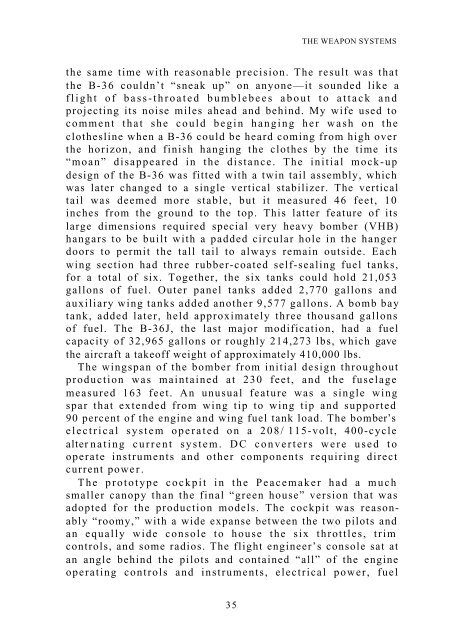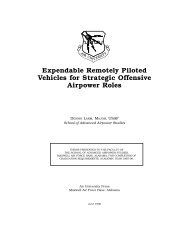Inside the Cold War - Project Gutenberg Consortia Center
Inside the Cold War - Project Gutenberg Consortia Center
Inside the Cold War - Project Gutenberg Consortia Center
You also want an ePaper? Increase the reach of your titles
YUMPU automatically turns print PDFs into web optimized ePapers that Google loves.
THE WEAPON SYSTEMS<br />
<strong>the</strong> same time with reasonable precision. The result was that<br />
<strong>the</strong> B-36 couldn’t “sneak up” on anyone—it sounded like a<br />
flight of bass-throated bumblebees about to attack and<br />
projecting its noise miles ahead and behind. My wife used to<br />
comment that she could begin hanging her wash on <strong>the</strong><br />
clo<strong>the</strong>sline when a B-36 could be heard coming from high over<br />
<strong>the</strong> horizon, and finish hanging <strong>the</strong> clo<strong>the</strong>s by <strong>the</strong> time its<br />
“moan” disappeared in <strong>the</strong> distance. The initial mock-up<br />
design of <strong>the</strong> B-36 was fitted with a twin tail assembly, which<br />
was later changed to a single vertical stabilizer. The vertical<br />
tail was deemed more stable, but it measured 46 feet, 10<br />
inches from <strong>the</strong> ground to <strong>the</strong> top. This latter feature of its<br />
large dimensions required special very heavy bomber (VHB)<br />
hangars to be built with a padded circular hole in <strong>the</strong> hanger<br />
doors to permit <strong>the</strong> tall tail to always remain outside. Each<br />
wing section had three rubber-coated self-sealing fuel tanks,<br />
for a total of six. Toge<strong>the</strong>r, <strong>the</strong> six tanks could hold 21,053<br />
gallons of fuel. Outer panel tanks added 2,770 gallons and<br />
auxiliary wing tanks added ano<strong>the</strong>r 9,577 gallons. A bomb bay<br />
tank, added later, held approximately three thousand gallons<br />
of fuel. The B-36J, <strong>the</strong> last major modification, had a fuel<br />
capacity of 32,965 gallons or roughly 214,273 lbs, which gave<br />
<strong>the</strong> aircraft a takeoff weight of approximately 410,000 lbs.<br />
The wingspan of <strong>the</strong> bomber from initial design throughout<br />
production was maintained at 230 feet, and <strong>the</strong> fuselage<br />
measured 163 feet. An unusual feature was a single wing<br />
spar that extended from wing tip to wing tip and supported<br />
90 percent of <strong>the</strong> engine and wing fuel tank load. The bomber’s<br />
electrical system operated on a 208/115-volt, 400-cycle<br />
alter nating current system. DC converters were used to<br />
operate instruments and o<strong>the</strong>r components requiring direct<br />
current power.<br />
The prototype cockpit in <strong>the</strong> Peacemaker had a much<br />
smaller canopy than <strong>the</strong> final “green house” version that was<br />
adopted for <strong>the</strong> production models. The cockpit was reasonably<br />
“roomy,” with a wide expanse between <strong>the</strong> two pilots and<br />
an equally wide console to house <strong>the</strong> six throttles, trim<br />
controls, and some radios. The flight engineer’s console sat at<br />
an angle behind <strong>the</strong> pilots and contained “all” of <strong>the</strong> engine<br />
operating controls and instruments, electrical power, fuel<br />
35






